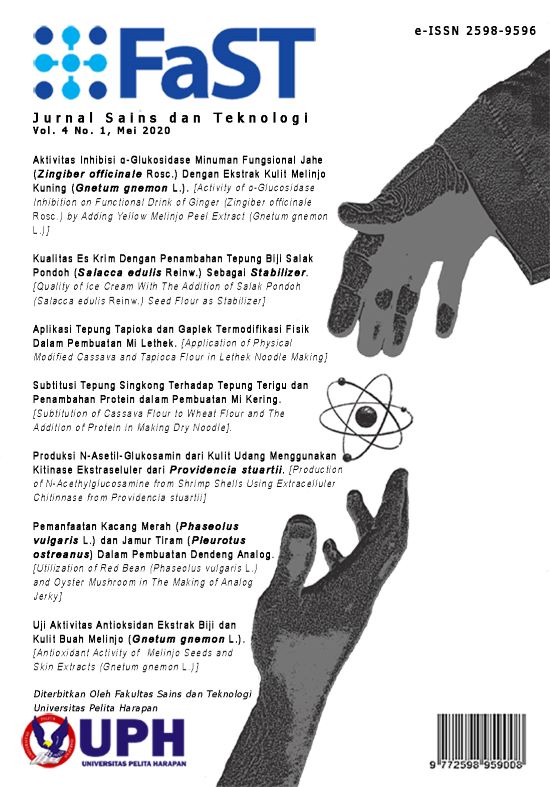PRODUKSI N-ASETILGLUKOSAMIN DARI KULIT UDANG MENGGUNAKAN KITINASE EKSTRASELULER DARI Providencia stuartii
Keywords:
ekstraseluler, kitin, kitinase, N-asetilglukosamin, Providencia stuartiiAbstract
Cangkang udang tersusun dari kitin. Salah satu turunan kitin, yaitu glukosamin, biasanya terdapat dalam bentuk N-asetilglukosamin dan dapat diproduksi melalui fermentasi enzimatis terhadap kitin dengan menggunakan mikroorganisme kitinolitik. Salah satu bakteri kitinolitik adalah Providencia stuartii. Penelitian ini dilakukan untuk menentukan kondisi fermentasi optimum, yaitu pH, suhu, konsentrasi substrat, dan lama inkubasi, untuk memproduksi N-asetilglukosamin menggunakan kitinase ekstraseluler dari Providencia stuartii. pH yang digunakan dalam fermentasi adalah 3, 4, 5, 6, 7, 8, dan 9, sedangkan suhu yang digunakan adalah 30, 40, 50, 60, 70 and 80oC. Hasil penelitian menunjukkan bahwa kitinase ekstraseluler kasar memiliki aktivitas optimum pada pH 5 dan suhu 40oC, yaitu berturut-turut sebesar 3,23 ± 0,06 U/ml dan 3,42 ± 0,06 U/ml. Kitinase ekstraseluler semi murni memiliki aktivitas optimum pada pH 7 dan suhu 40oC, yaitu berturut-turut sebesar 4,74 ± 0,06 U/ml and 4,44 ± 0,06 U/ml. Selanjutnya, konsentrasi kitin sebagai substrat yang digunakan adalah sebesar 0,5; 1; 1,5; dan 2% dengan lama inkubasi 2, 4, 6, dan 24 jam. Konsentrasi N-asetilglukosamin tertinggi diperoleh setelah lama inkubasi 6 jam dengan konsentrasi substrat sebesar 1%, yaitu sebesar 933,89 ± 12,55 ppm menggunakan kitinase ekstraseluler kasar dan 1050,56 ± 12,54 ppm menggunakan kitinase ekstraseluler semi murni.References
Bettelheim, F.A., Brown, W.H., Campbell, M.K., and Farrell, S.O. 2009. Introduction to General, Organic and Biochemistry. Canada: Cengage Learning. Brzezinska, M.S., Jankiewicz, U., Burkowska, A., and Walczak, M. 2013. Chitinolytic microorganisms and their possible application in environmental protection. Current Microbiology 68 (1) : 71-81. Cahyono, E., Suptijah, P., and Wientarsih, I. 2014. Development of a pressurized hydrolysis method for producing glucosamine. Asian Journal of Agriculture and Food Sciences 2 (5) : 390-396. Cheba, B.A., Zaghloul, T.I., El-Mahdy, A.R., and El-Massry, M.H. 2016. Effect of pH and temperature on Bacillus sp. R2 chitinase activity and stability. Procedia Technology 22:471-477. Clark, S., Jung, S., and Lamsal, B. 2014. Food Processing: Principles and Applications, 2nd ed. West Susssex: John Wiley & Sons. Einbu, A. 2007. Characterisation of chitin and a study of its acid-catalysed hydrolysis. Biotechnology, Trondheim, Norwergia: Norwegian University of Science and Technology, Ph.D. Dissertation. Gangwar, M., Singh, V., Pandey, A.K., Tripathi, C.K.M., and Mishra, B.N. 2016. Purification and characterization of chitinase from Streptomyces violascnes NRRL B2700. Indian Journal of Experimental Biology 54 (1): 64-71. Haliza, W. dan Suhartono, M.T. 2012. Karakteristik kitinase dari mikroba. Buletin Teknologi Pascapanen Pertanian 8 : 1-14. Hamid, R. 2013. Isolation and characterization of microbial chitinases. New Delhi: Jamia Hamdard. Hamid, R., Khan, M.A., Ahmad, M., Ahmad, M.M., Abdin, M.Z., Musarrat, J. and Javed, S. 2013. Chitinases: an update. Journal of Pharmacy and Bioallied Sciences 5 (1) : 21-29. Hardi, J., Rusian, Razak, A.R., and Silva. 2017. Karakterisasi enzim kitinase dari isolat bakteri termofilik B1211 asal air panas bora. Jurnal Riset Kimia 3 (2) : 172-179. Hardoko, Mastuti, T.S., Puspasari, D., and Halim, Y. 2019. Utilization of crude intracellular chitinase enzyme from Providencia stuartii for glucosamine production from shrimp shells. Reaktor 19 (2) : 62-67. Hardoko, Josephine, C., Handayani, R., and Halim, Y. 2020. Isolation, identification and chitinolytic index of bacteria from rotten tiger shrimp (Penaeus monodon) shells. AACL Bioflux 13 (1) : 360-371. Herdyastuti, N. and Cahyaningrum, S.E. 2017. Analysis of N-acetylglucosamine from enzymatic degradation of amorphous chitin. Rayasan Journal Chemistry 10 (1) : 226-233. Jolles, P. and Muzzarelli, R.A.A. 2012. Chitin and Chitinases. Basel: Birkhauser Basel. Kokate, C. 2011. Textbook of Pharmaceutical Biotechnology. New Delhi: Elsevier. Krithika, S. and Chellaram, C. 2016. Isolation, screening and characterization of chitinase producing bacteria from marine wastes. International Journal of Pharmacy and Pharmaceutical Sciences 8 (5) : 34-36. Maggadani, B.P., Setyahadi, S., dan Harmita. 2017. Skrining dan evaluasi aktivitas kitinase dari sembilan isolat bakteri lokal. Pharmaceutical Sciences and Research 4 (1) : 13-24. Narendrakumar, G., Namasivayam, S.K.R, and Singh, R.A.I.S. 2015. Production and optimization of extracellular fungal chitinase produced by Metarhizium anisopliae sorokin through submerged and solid state fermentation. Research Journal of Pharmacy and Technology 8 (3) : 280-284. Pomeranz, Y. 2012. Functional Properties of Food Components. Florida: Elsevier. Pratiwi, R.S., Susanto, T.E., Wardani, Y.A.K., dan Sutrisno, A. 2015. Enzim kitinase dan aplikasi di bidang industri: kajian pustaka. Jurnal Pangan dan Agroindustri 3 (3) : 878-887. Ramansyah, M. dan Sudiana, I.M. 2003. Optimasi analisis amilase dan glukanase yang diekstrak dari miselium Pleurotus ostreatus dengan asam 3,5 dinitrosalisilat. Berkala Penelitian Hayati 9 : 7-12. Renneberg, R. 2008. Biotechnology for Beginners. Massachusetts: Elsevier. Soeka, Y.S., Triana, E., dan Setianingrum, N. 2010. Aktivitas aktinomisetes dari Bangka Belitung koleksi bidang mikrobiologi, Puslit Biologi-LIPI dalam memproduksi enzim kitinase. Jurnal Teknik Lingkungan 11 (3) : 417-423. Thacker, U., Parikh, R., Shouche, Y., and Madamwar, D. 2006. Hexavalent chromium reduction by Providencia sp. Process Biochemistry 41 : 1332-1337. Zbircea, R.I., Menghiu, G., Matica, A., and Ostafe, V. 2016. Use of 3,5-dinitrosalicylic acid reaction to study the chitosan hydrolysis. New Frontiers in Chemistry 25 : 145-153. Zhao, G. 2017. Mineral Containing Proteins: Roles in Nutrition. Singapore: Springer.
Downloads
Published
Issue
Section
License
“Authors who publish with this journal agree to the following terms:
1) Authors retain copyright and grant the journal right of first publication with the work simultaneously licensed under a Creative Commons Attribution License (CC-BY-SA 4.0) that allows others to share the work with an acknowledgement of the work's authorship and initial publication in this journal.
2) Authors are able to enter into separate, additional contractual arrangements for the non-exclusive distribution of the journal's published version of the work (e.g., post it to an institutional repository or publish it in a book), with an acknowledgement of its initial publication in this journal.
3) Authors are permitted and encouraged to post their work online (e.g., in institutional repositories or on their website). The final published PDF should be used and bibliographic details that credit the publication in this journal should be included.”



